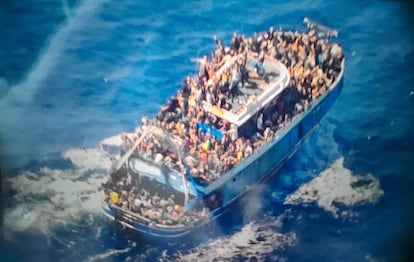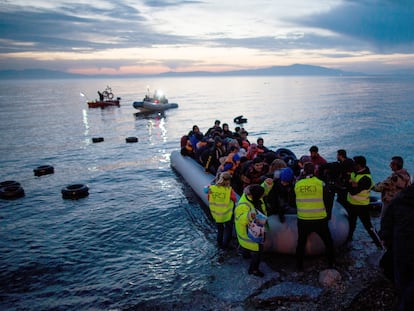Migrants from shipwreck off Greece warned of danger: ‘The captain has fled. We need a solution’
The fishing boat, believed to have been carrying up to 750 people, sank after being escorted for hours by a Greek coast guard vessel
More than 48 hours after an old fishing boat capsized in Greek waters, leaving a trail of hundreds of missing migrants and at least 78 corpses in the sea, it is getting harder to reconstruct what happened. The main question is whether a rescue operation activated in time by the Greek authorities would have prevented the deaths. Rescuers saved 104 people, all men, but it is suspected that numerous women and children were trapped in the ship’s hold as it sank, and nobody knows for sure how many people were traveling in the trawler. Nine people were arrested Thursday on suspicion of smuggling, AP reported. Based on the accounts of the survivors, the International Organization for Migration calculated that between 700 and 750 people were traveling on the ship. The estimate includes a minimum of 40 children. These figures suggest it could become one of the greatest tragedies ever recorded in the Mediterranean.
Official information is scarce and the Greek Coast Guard has evaded any responsibility for the disaster. In an official statement, the agency insisted that the migrants refused help, that they only requested food and insisted on continuing their journey to Italy, their destination. Rescue operations, however, are not governed by negotiations with the ship’s occupants, but are regulated by law. “Aid is never a contract. If an authority, for whatever reason, cannot intervene, it must ask for the intervention of others,” explains Vittorio Alessandro, a retired admiral of the Italian Coast Guard. “The elements to intervene provided for in European regulations were there: an overloaded boat, absence of lifeguards, no captain and poor seaworthiness,” he adds.
The story of this shipwreck is reminiscent of the one that occurred in Cutro, southern Italy, on February 26, when a ship carrying almost 200 people sank 40 meters off the Italian coast. At least 94 refugees died, including 35 children. Both the European border agency, Frontex, and the Italian authorities had located the overcrowded fishing boat, which was caught in the middle of a storm. The Italian Coast Guard did not launch a rescue operation until the ship had already broken into pieces.
The following is a partial reconstruction of this latest shipwreck through the information provided by NGOs, Greek authorities, Frontex and survivors, who will be transferred to the Malakasa refugee camp, 50 kilometers (31 miles) from Athens, from the port of Kalamata, where they have spent their first hours on dry land.
The departure. The old trawler departed on June 9 from Tobruk, in eastern Libya, 150 kilometers (93 miles) from the border with Egypt. There are no certainties about its occupants and the number varies between 400 and 750, depending on the source. Their nationalities are also unclear, although Greek sources said the majority were Syrians, Egyptians and Pakistanis. Two of those passengers were cousins of Tarek Aldroobi, a Syrian living in Germany, who traveled to the port of Kalamata, where the survivors were disembarked, only to discover to his distress that his cousins were not among them. According to Aldroobi, each of the passengers paid between €4,000 and €6,000. That’s 14 times what it would cost to fly a traveler with a visa from Tripoli to Rome.
The sharp increase in the departures of large trawlers capable of transporting up to 500 people from eastern Libya was already a phenomenon verified by Frontex, according to a confidential report from the European Commission. Departures from Cyrenaica, the region where Tobruk is located, have increased this year by 531% compared to 2022, according to the document. It is no accident. Since June 1, Libyan National Army (LNA) forces have detained more than 1,000 migrants in Tobruk and Musaid, both in the east of the country. “When I came to Europe from Libya, the boats left from the west and the trip lasted one day. But since the controls and the pressure increased, the ships set sail more and more to the east and now it takes six days to sail to reach Italy”, says Aldroobi.
Alerts. After four days of travel, on Tuesday, June 13 at 9:35 a.m., the activist Nawal Soufi posted the following message in Italian on her social networks: “I am managing the SOS of a ship with 750 people on board, which sailed from Libya and is in trouble right now. The people on board are in danger from drinking seawater, the water has run out after four days of navigation.”
The statement from the Greek Coast Guard says it received a notice from the Maritime Coordination Center in Rome at 11:00 a.m. about a “fishing boat with a large number of migrants.” At 12:47 p.m. Frontex spotted the ship and notified Italian and Greek authorities. The fishing vessel was 87 kilometers (54 miles) from the Greek coast.
The Greek strategy. Almost three hours after the official warning, at 1:50 p.m., Greek authorities sent a helicopter in search of the ship. Barely 10 minutes later, the fishing boat was contacted for the first time. According to the Greek authorities, it did not request any assistance from the Coast Guard or Greece.
At 3:17 p.m. in Greece, the Alarm Phone organization, which manages an emergency telephone number for migrants embarking for Europe, says that it received the first call from the ship. In a later call, at 5:13 p.m., one of its occupants assured them that the boat was not moving, that they lacked water and food and added a disturbing fact: “The captain has fled in a small boat. Please, we need a solution.” According to their statement, they received the ship’s GPS coordinates at the time of that second call and, after trying to obtain more information to no avail, at 5:53 p.m. they sent an email “to the Hellenic authorities and other agents, including Frontex,” to alert them.
The helicopter sighted the vessel at 2:35 p.m. and the aerial images were published by the local media. In them it is possible to see dozens of people on the deck, crowded together, raising their hands to the sky. According to the Hellenic authorities, “it was sailing with a constant course and speed and with a large number of people on its outer decks.”
As the Greek Coast Guard directed one of its frigates into the area, the maritime authorities radioed nearby vessels to change their course and report on the movements and general condition of the fishing vessel.

Food and the alleged refusal of aid. At 6:00 p.m. a second Coast Guard helicopter took off to monitor the fishing boat and Greek authorities contacted its occupants for the second time. On the other side of the satellite phone, a voice in English assured, according to the official statement, that the ship “was not in danger” and that they only wanted food and water because their wish was “to continue towards Italy.”
The version that the migrants refused help does not coincide with the information provided by the NGO and the activist who had contact with the passengers. “The ship is crowded and moving from one side to the other,” Alarm Phone heard in one of its communications.
Two boats with Maltese and Greek flags came to bring food to the fishing boat at 4:00 p.m. and 7:00 p.m., respectively. The activist Nawal Soufi has provided her version of events on Facebook: “The situation became even more complicated when one boat came right up to the other, tied ropes to two points and began to throw bottles of water. The migrants felt in extreme danger because they feared that the ropes could capsize the boat and that the fights for the water could cause a shipwreck […] The situation became even more dramatic: the migrants were confused and did not understand if it was a rescue operation or a way to put their lives in even more danger.”
Anabel Montes, who until two months ago was responsible for rescue operations aboard the humanitarian ship Geo Barents and has more than eight years of experience in the field, questions the actions of the Greek Coast Guard. For her, the approach to the fishing boat is “a very dangerous maneuver” that can cause a sudden movement that destabilizes the ship. Montes explains that the ship’s stability was highly compromised. “The more people and higher up, the easier it is for the metacenter to rise and for the ship to capsize,” she said.
Surveillance without rescue. According to the Greek statement, maritime authorities monitored the ship from 3:30 p.m. to 9:00 p.m. from its operations room. At 10:40 p.m., a Coast Guard boat approached the fishing vessel, observing it “from a distance.” “No problem was found in its navigation, since it had a constant course and speed,” says the official version. Then at 1:40 a.m. a call from the ship warned that the engine had failed and that they had stopped moving. The Coast Guard vessel then approached and verified the alert. According to Greek authorities, 24 minutes later the fishing boat began to sway sharply and capsized. In 15 minutes the ship sank completely and its occupants were submerged in one of the deepest areas of the Mediterranean. Only then did the authorities activate a rescue operation.
Sign up for our weekly newsletter to get more English-language news coverage from EL PAÍS USA Edition
Tu suscripción se está usando en otro dispositivo
¿Quieres añadir otro usuario a tu suscripción?
Si continúas leyendo en este dispositivo, no se podrá leer en el otro.
FlechaTu suscripción se está usando en otro dispositivo y solo puedes acceder a EL PAÍS desde un dispositivo a la vez.
Si quieres compartir tu cuenta, cambia tu suscripción a la modalidad Premium, así podrás añadir otro usuario. Cada uno accederá con su propia cuenta de email, lo que os permitirá personalizar vuestra experiencia en EL PAÍS.
¿Tienes una suscripción de empresa? Accede aquí para contratar más cuentas.
En el caso de no saber quién está usando tu cuenta, te recomendamos cambiar tu contraseña aquí.
Si decides continuar compartiendo tu cuenta, este mensaje se mostrará en tu dispositivo y en el de la otra persona que está usando tu cuenta de forma indefinida, afectando a tu experiencia de lectura. Puedes consultar aquí los términos y condiciones de la suscripción digital.
More information
Últimas noticias
James Cameron: ‘For the films I like to make to continue to exist, we have to find a way to make them cheaper’
Families demand repatriation of bodies of Colombians who died in Ukraine: ‘This war is a slaughterhouse for foreigners’
The guardians of the meteorites of the Argentine Chaco
Helen Levitt, the photographer who captured the theater of the everyday
Most viewed
- Christian Louboutin: ‘Young people don’t want to be like their parents. And if their parents wear sneakers, they’re going to look for something else’
- US sanctions against jailed cartel leader ‘El Marro’ highlight Mexico’s lack of control over its prisons
- Cartels in Mexico take a leap forward with narco-drones: ‘It is criminal groups that are leading the innovation race’
- Liset Menéndez de la Prida, neuroscientist: ‘It’s not normal to constantly seek pleasure; it’s important to be bored, to be calm’
- ‘El Limones’ and the growing union disguise of Mexican organized crime









































